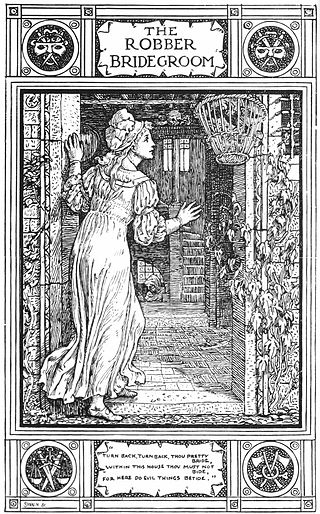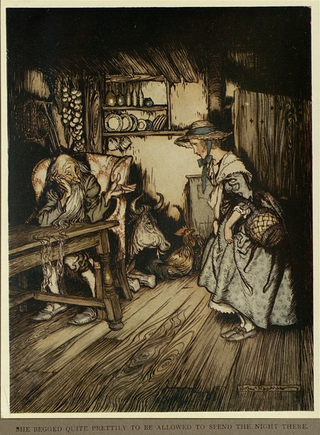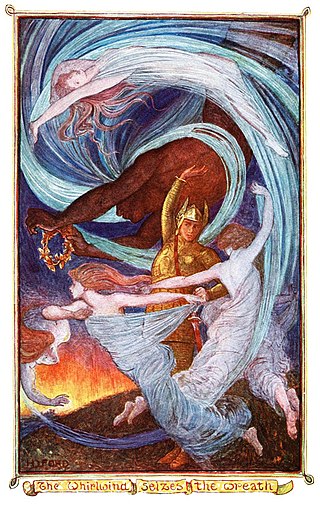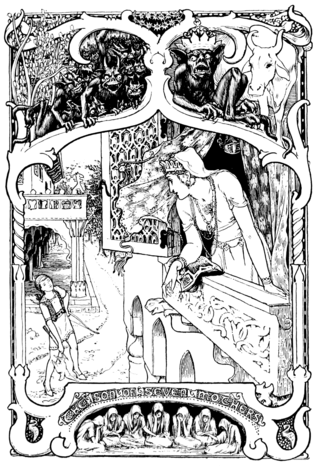Related Research Articles

"The Elves and The Shoemaker" is a set of fairy tales collected by the Brothers Grimm about a poor shoemaker who receives much-needed help from three young helpful elves.
"The Three Princesses of Whiteland" is a Norwegian fairy tale, collected by Norwegian writers Peter Christen Asbjørnsen and Jørgen Moe in their collection of folktales and legends Norske folkeeventyr (1879). Scottish poet and novelist Andrew Lang collected it his The Red Fairy Book (1890).

"The Blue Bird" is a French literary fairy tale by Madame d'Aulnoy, published in 1697. An English translation was included in The Green Fairy Book, 1892, collected by Andrew Lang.
Rushen Coatie or Rashin-Coatie is a Scottish fairy tale collected by Joseph Jacobs in his More English Fairy Tales.

"The Robber Bridegroom" is a German fairy tale collected by the Brothers Grimm, tale number 40. Joseph Jacobs included a variant, Mr Fox, in English Fairy Tales, but the original provenance is much older; Shakespeare alludes to the Mr. Fox variant in Much Ado About Nothing, Act 1, Scene 1:
"One-Eye, Two-Eyes, and Three-Eyes" is a German fairy tale collected by the Brothers Grimm, tale number 130. Andrew Lang included it, as "Little One-eye, Little Two-eyes, and Little Three-eyes", in The Green Fairy Book. It is Aarne-Thompson type 511.
Laughing Eye and Weeping Eye or The Lame Fox is a Serbian fairy tale collected by Albert H. Wratislaw in his Sixty Folk-Tales from Exclusively Slavonic Sources, number 40. Andrew Lang included it in The Grey Fairy Book. Parker Fillmore included the tale as The Little Lame Fox in his book Jugoslav Fairy Tales.

"The Hut in the Forest" is a German fairy tale collected by the Brothers Grimm. Andrew Lang included it in The Pink Fairy Book (1897). It is Aarne-Thompson type 431.
The Enchanted Wreath is a Scandinavian fairy tale, collected in Benjamin Thorpe in his Yule-Tide Stories: A Collection of Scandinavian and North German Popular Tales and Traditions. Andrew Lang adapted a variant of it for The Orange Fairy Book. It is Aarne-Thompson type 403B, the black and the white bride, and includes an episode of type 480, the kind and the unkind girls.

"The Twelve Brothers" is a German fairy tale collected by the Brothers Grimm in Grimm's Fairy Tales. Andrew Lang included it in The Red Fairy Book.
The Sharp Grey Sheep or The Sharp-Horned Grey Sheep is a Scottish fairy tale collected by John Francis Campbell in Popular Tales of the West Highlands, listing his informant as John Dewar, labourer, from Glendaruail, Cowal.
Prince Hat under the Ground is the Swedish version of an old Scandinavian fairy tale. The Norwegian version is called East of the Sun and West of the Moon.
"The Three Sisters" or Green Meadow is an Italian literary fairy tale written by Giambattista Basile in his 1634 work, the Pentamerone. It tells the story of a maiden having secret encounters with a prince with the use of magic, him almost losing his life and her having to search for a cure for him.
Father Roquelaure is a French fairy tale collected by Achille Millien.
Le Serpentin Vert is a French fairy tale written by Marie Catherine d'Aulnoy, popular in its day and representative of European folklore, that was published in her book New Tales, or Fairies in Fashion, in 1698. The serpent is representative of a European dragon. His description is: "he has green wings, a many-coloured body, ivory jaws, fiery eyes, and long, bristling hair."

In folklore and literature, the Fairy Queen or Queen of the Fairies is a female ruler of the fairies, sometimes but not always paired with a king. Depending on the work, she may be named or unnamed; Titania and Mab are two frequently used names. Numerous characters, goddesses or folkloric spirits worldwide have been labeled as Fairy Queens.

"The Fairy Aurora" is a fairy tale written by Ioan Slavici and published in June 1872. Mihai Eminescu urged him to write his first story, which was read at Junimea in two sessions and was published in the magazine Convorbiri Literare.
La Fada Morgana is a Catalan fairy tale or rondalla, first collected by Majorcan priest and author Antoni Maria Alcover. It is related to the cycle of the Animal as Bridegroom and distantly related to the Graeco-Roman myth of Cupid and Psyche, in that the heroine is forced to perform difficult tasks for a witch.

The Son of Seven Mothers or The Son of Seven Queens is an Indian folktale, first published in the late 19th century by author Flora Annie Steel. It is classified in the international Aarne-Thompson-Uther Index as ATU 462, "The Outcast Queens and the Ogress Queen".
Molla Badji is an Iranian folktale collected and translated by researcher Adrienne Boulvin and published in 1975. It is related to the theme of the calumniated wife and is classified in the international Aarne-Thompson-Uther Index as ATU 707, "The Three Golden Children".
References
- ↑ Narváez, Peter (1997). The Good People: New Fairylore Essays. University Press of Kentucky. p. 126.
- ↑ Alexander, Marc; A Companion to the Folklore, Myths and Customs of Britain, 2002
- ↑ Kerven, Rosalind (2005). Northumberland Folk Tales. Antony Rowe Ltd. p. 532.
- ↑ "ML" stands for "migratory legend". Haase, Donald (2008). The Greenwood Encyclopedia of Folktales and Fairy Tales. Greenwood Publishing Group. p. 301. ISBN 978-0-313-33441-2.
- ↑ D. L. Ashliman,Midwife (or Godparent, or Nurse) for the Elves: fairy tales of Aarne-Thompson-Uther types 476*, 476**, and migratory legends of Christiansen type 5070